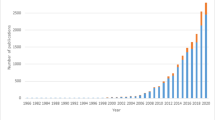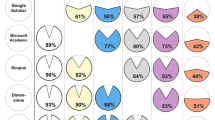Abstract
The present study views author self-citations, as a blend of experience and cognition of authors. This paper supports to lay down emphasis on consciousness and cognition of authors while assessing author self-citations.
Similar content being viewed by others
References
Baird, L. M., Oppenheim, C. (1994), Do citations matter? Journal of Information Science, 20: 2–15.
Bonzi, S., Snyder, H. W. (1991), Motivations for citations: a comparison of self citation and citation to others, Scientometrics, 2: 245–254.
Case, D. O., Higgins, G. M. (2000), How we can investigate citation behaviour?: A study of reasons for citing literature in communication, Journal of the American Society for Information Science, 51: 635–645.
Chubin, H. (1976), The conceptualisation of scientific specialities, Sociological Quarterly, 17: 448–476.
Crane, C. (1965), Scientists at major and minor universities: A study of productivity and recognition, Americian Sociological Review, 30: 699–714.
Cronin, B. (1984), ThE Citation Process: The Role and Significance of Citations in Scientific Communication, London, Taylor Graham, p. 103.
Garfield, E. (1970), Citation index for studying science, Nature, 227: 669–671.
Garfield, E. (1979), Citation Indexing: Its Theory and Application in Science, New York, Wiley.
Gieryn, T. F. (1978), Problem retention and problem change in science, Sociological Inquiry, 48: 96–115.
Gilbert, G. N. (1977), Referencing as persuasion, Social Studies of Science, 7: 113–122.
Lawani, S. M. (1982), On the heterogeneity and classification of author self-citations, Journal of the American Society for Information Science, 33: 281–284.
Leydesdorff, L. (1998), Theories of citation?, Scientometrics, 43: 5–25.
Macroberts, M. H., Macroberts, B. R. (1986), Quantitative measures of communication in science: A study of the formal level, Social Studies of Science, 16: 151–172.
Magnusson, E. (1991), Character analysis of a science, Nature, 352: 103.
Narin, F., Olivastro, D. (1986), National trends in physics and technology, Czechoslovak Journal of Physics, B36: 101–106.
Peters, H. P. F., Van Raan, A. F. J. (1991), Structuring scientific activities by co-author analysis. An exercise on a university faculty level, Scientometrics, 20: 235–255.
Trimble, V. (1986), Self-citation rates of astronomical papers, Czechoslovak Journal of Physics, B36: 175–179.
Vinkler, P. (1991), Possible causes of differences in information impact of journals, from different subfields, Scientometrics, 20: 145–161.
White, M., Wang, P. (1997), A qualitative study of citing behaviour: Contributions, criteria, and multilevel documentation concerns, Library Quarterly, 67: 122–154.
Wouters, P. (1999), Beyond the Holy Grail: from citation theory to indicator theories, Scientometrics, 44: 561–580.
Author information
Authors and Affiliations
Rights and permissions
About this article
Cite this article
Pichappan, P., Sarasvady, S. The other side of the coin: The intricacies of author self-citations. Scientometrics 54, 285–290 (2002). https://doi.org/10.1023/A:1016070029935
Issue Date:
DOI: https://doi.org/10.1023/A:1016070029935




